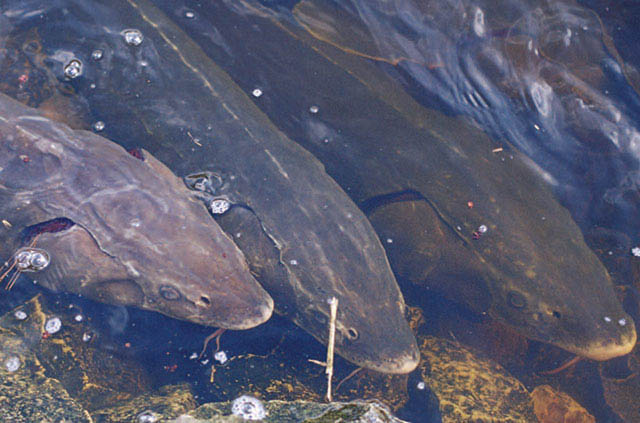When the Endangered Species (ESA) Act took effect in 2008, Lake Sturgeon was listed as a special concern. The species was divided into three different populations on September 10, 2009, and classified as endangered (populations of the Great Lakes-Upper St. Lawrence and Northwestern Ontario) and of special concern (population of the Hudson Bay-James Bay). The populations of the Great Lakes-Upper St. Lawrence were reassessed in November 2017 and the lake sturgeon was considered as endangered. Lake Sturgeon can be found all across North America, from Alberta to the lower Mississippi.
The Sturgeon is assessed as endangered based on declines in mature individuals over the past 3 generations where the cause of decline has not stopped in Ontario. There are some relatively large stable populations, but compared to previous periods, most populations are still at low levels. Hydroelectric production and industrial exploitation have been greatly involved in the decline of the sturgeon.
Lake Sturgeon, weighing up to 180 kilogrammes (396 pounds) and reaching over two metres long, (6 feet) is Canada’s largest freshwater fish. Its body is covered with large bony plates, pronounced in juveniles but less pronounced in larger fishes. It has an extended snout with four whisker-like organs hanging near the mouth. On its back and sides with a lighter belly, it is dark to light brown or grey.

Almost exclusively, the Lake Sturgeon lives in freshwater lakes and rivers with soft mud, sand, or gravel bottoms and is a bottom feeder. Usually, they are found at depths of five to 20 metres. (16 feet to 65 feet) With gravel and boulders at the bottom, they spawn in relatively shallow, fast-flowing water (usually below waterfalls, rapids, or dams). They can, however, spawn in deeper water where there is habitat available. In large rivers with heavy currents, they are also known to breed on open shoals.
Some Quick Facts about Lake Sturgeon
- The oldest known Lake Sturgeon specimen is 155 years old from Lake Huron; the largest recorded Lake Sturgeon was from the Manitoba Roseau River, 185 kg in weight (407 pounds) and 4.6 m (15 feet) in length.
- The inner lining of the swim bladder of Lake Sturgeon (an air-filled sac that helps float the fish) was used to clarify wine, beer and other liquids.
- Lake Sturgeon subsistence fishing is a long-standing practice for many Aboriginal groups.
- Over the season, Lake Sturgeon migrates and moves upstream to spawning areas and downstream to the deeper water; some adults move up to 400 km (248 miles) to spawning areas.
Recovery Strategy
Under the ESA, the recovery strategy offers the best scientific information available about what is needed to achieve species recovery. A plan for recovery outlines the needs of the habitat and the threats to the species’ survival and recovery. It also provides suggestions on the conservation and recovery goals, the approaches to achieving those objectives and the areas to be included in the creation of the regulation of ecosystems.






